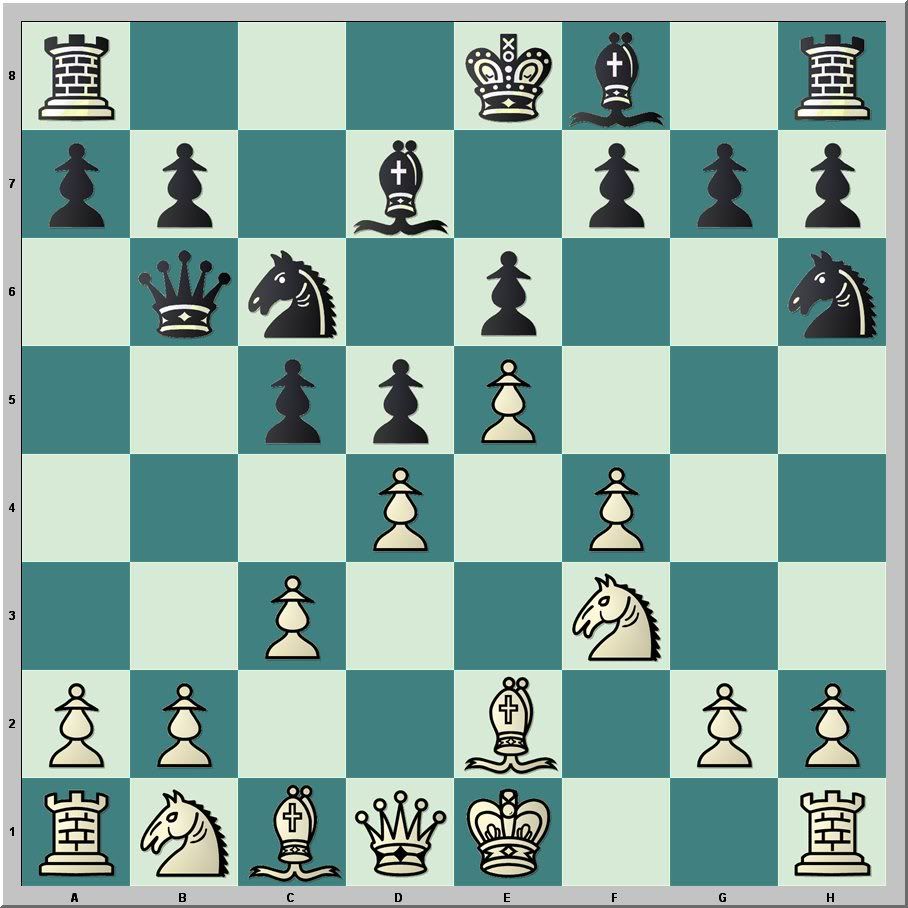When my opponent played 5.f4 on Sunday, it did not strike me as a particularly bad move. Kingside pawn storms have given me trouble in the French on more than one occasion, so the move seems sensible. But, as this early pawn thrust weakens the diagonal where the white king wants security, I started my pressure along that line instantly (something I had failed to do in a correspondence game a few years ago). Two moves later my opponent, a young C-class player, failed to adequately protect his d4 pawn and I seized both the material and a lasting initiative. After a few tactical inaccuracies in a very difficult position, my opponent conceded defeat and we proceeded to the skittles room to determine why White's game fell apart so fast. He recognized that 5.f4 seemed dubious, but I highlighted 7.Be2 as the critical error.
We reached the French Advance via the Franco-Benoni, a dubious choice by Black that I trot out from time to time and often regret.
Clark,J (1553) - Stripes,J (1835) [C02]
Collyer Memorial, Spokane 2011
1.e4 e6 2.d4 c5?! 3.c3 d5 4.e5 Nc6 5.f4

The database of my games reveals that 5.f4 was new to me in OTB play, but another database has fifty instances of the move in online play. I have played it eight times in online blitz, have faced it forty times in the same, and twice have faced it in online correspondence games. Black scores well in these games.
5...Qb6
I played the less precise 5...Bd7 in a game on Red Hot Pawn in 2006. It continued 6.Nf3 cxd4 7.cxd4 f6N 8.Nc3 Nge7 9.exf6 gxf6 10.Nh4 Bg7 11.Qh5+ Kf8 12.Be3 Be8 13.Qe2 Ng6 14.g3 f5 15.Nf3 Bf7 16.Bg2 Qb6 17.0–0? and I won a pawn, going on to win the game in fifty-five moves.
6.Nf3 Nh6
The move 6...Nge7? was played in the correspondence game Clayton-Armstrong, Scotland 1993 and is annotated on Neven's CD. White won in thirty-two moves.
7.Be2? Bd7

8.b3
On a turn-based website where I no longer play, my opponent continued 8.0–0. After 8...cxd4 9.cxd4 Nf5 10.Bd3 we reach a position that I use as a training position in my teaching of young players. Black wins a pawn with 10... Ncxd4 11.Nxd4 Qxd4+.
8...cxd4 9.cxd4 Bb4+

10.Kf1
10.Bd2 was played in Stesser-Wallin, Vaxjo 1992 and Black won in twenty-one moves.
10.Kf2 is better.
10... Nf5 11.g4? A bad move in a bad position 11...Nfxd4 12.a3 Nxe2 13.Qxe2 Bc5 14.Nc3 Nd4 15.Nxd4 Bxd4 16.Bb2 Bxc3 17.Bxc3 Bb5 0–1
This miniature was my only game in this year's Dave Collyer Memorial. Work responsibilities (teaching history) kept me from playing on Saturday, so I stood by on Sunday as the house player and was needed in the fifth round.
Reference Games
Cochrane,J - Staunton,H [C02]
London 1841
1.e4 e6 2.d4 d5 3.e5 c5 4.c3 Nc6 5.f4 Qb6 6.Nf3 Nh6 7.Bd3 Be7 8.Bc2 0–0 9.0–0 f5 10.Kh1 Bd7 11.h3 Rac8 12.a3 a5 13.Rg1 cxd4 14.cxd4 Qc7 15.Nc3 Na7 16.g4 b5 17.gxf5 b4 18.fxe6 Bxe6 19.Ng5 Bxg5 20.fxg5 Nf5 21.Bxf5 Bxf5 22.Ne2 Be4+ 23.Kh2 Qc2 24.Qe1 Nb5 25.Be3 Qd3 26.Rg3 Rc2 0–1
Mc Connell,J - Morphy,P [C02]
New Orleans 1850
1.e4 e6 2.d4 d5 3.e5 c5 4.c3 Nc6 5.f4 Qb6 6.Nf3 Bd7 7.a3 Nh6 8.b4 cxd4 9.cxd4 Rc8 10.Bb2 Nf5 11.Qd3 Bxb4+ 12.axb4 Nxb4 13.Qd2 Rc2 14.Qd1 Ne3 15.Bc3 Nxd1 16.Kxd1 Ra2 17.Rxa2 Nxa2 0–1
Steinitz,W - Golmayo,C [C02]
Havana 1888
1.e4 e6 2.d4 d5 3.e5 c5 4.c3 Nc6 5.f4 Qb6 6.Nf3 Bd7 7.dxc5 Bxc5 8.Bd3 Be3 9.Na3 Bxc1 10.Qxc1 Nge7 11.Nc2 Rc8 12.Ne3 Nb4 13.Be2 0–0 14.Qd2 Qxe3 15.Qxe3 Nc2+ 16.Kf2 Nxe3 17.Kxe3 f6 18.g3 Nc6 19.exf6 gxf6 20.Rad1 Rc7 21.Rhe1 Re8 22.Kf2 Kg7 23.Nh4 Ne7 24.Rd2 Bc6 25.Bh5 Ng6 26.f5 exf5 27.Rxe8 Bxe8 28.Nxf5+ Kf8 29.Rxd5 Rd7 30.Rxd7 Bxd7 31.Bxg6 hxg6 32.Ne3 Be6 33.b3 Ke7 34.h4 Kd6 35.Kf3 b5 36.Ke4 a5 37.g4 a4 38.bxa4 bxa4 39.a3 Bf7 40.Kd4 Kc6 41.c4 Kd6 42.Nd5 f5 43.gxf5 gxf5 44.Nf4 Bg8 45.c5+ Kc6 46.h5 Bf7 47.h6 Bg8 48.Nd5 Bh7 49.Nf6 1–0












As you know, James, I've played many a game on the White side of the Advance French. I definitely have an opinion on 5.f4.
ReplyDeleteWhen I see a move like 5.f4?, I cringe. It's a positional blunder. White is wasting a move to guard the wrong pawn--he needs to be focussed on tending to his d4 pawn right away with 5.Nf3. Also, it opens up new weaknesses: at e3 and along the a7-g1 diagonal. And, worst of all, it gives up any hope of doing something useful with the black-squared bishop on the kingside. Now that poor bishop is consigned to permanent pawn guarding duty.
White sometimes plays f4 in the Advance French, but only in special circumstances. To play it immediately throws away most of the flexibility and dynamicism in his position.
In the french opening the focus is about the d4 square. This f4 move doesn't really do that. f4 is only played in variations where black plays f6, then an extra guard of e5 is a good idea.
ReplyDeleteDavid, thanks for the clear explanation. Several of your French Advance games have been among my study material, including my best played loss.
ReplyDeleteThanks chesstiger.
No soy un sabio quiero aprender del que sabe.
ReplyDelete